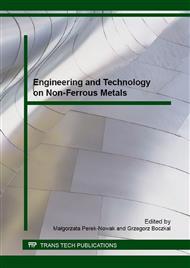p.265
p.270
p.276
p.284
p.293
p.299
p.308
p.314
p.321
Hydrometallurgical Treatment of Smelted Low-Grade WEEE in Ammoniacal Solutions
Abstract:
Hydrometallurgical routes of copper recovery from smelted low-grade e-waste are presented. Electronic scrap was smelted to produce Cu–Zn–Ag-Sn alloys of various phase compositions. The alloys were then treated in the following ways: (a) anodic dissolution with simultaneous metal electrodeposition using ammoniacal solutions with various ammonium salts (chloride, carbonate, sulfate). This resulted in the separation of metals, where lead, silver and tin accumulated mainly in the slimes, while copper was transferred to the slime, electrolyte and then recovered on the cathode. (b) leaching in ammoniacal solutions of various compositions and then copper electrowinning. Alloy was leached in chloride, carbonate, sulfate and thiosulfate baths. This resulted in the separation of the metals, wherein copper and zinc were transferred to the electrolyte, while metallic tin and silver as well as lead remained in the slimes. Copper was selectively recovered from the ammoniacal solutions by the electrolysis, leaving zinc ions in the electrolyte. The best conditions of the alloy treatment were obtained, where the final product was copper of high purity (99.9%) at the current efficiency of 60%. Thiosulfate solution was not applicable for the leaching of the copper alloy due to secondary reactions of the formation of copper(I) thiosulfate complexes and precipitation of copper(I) sulfide.
Info:
Periodical:
Pages:
293-298
Citation:
Online since:
February 2016
Authors:
Keywords:
Price:
Сopyright:
© 2016 Trans Tech Publications Ltd. All Rights Reserved
Share:
Citation:


